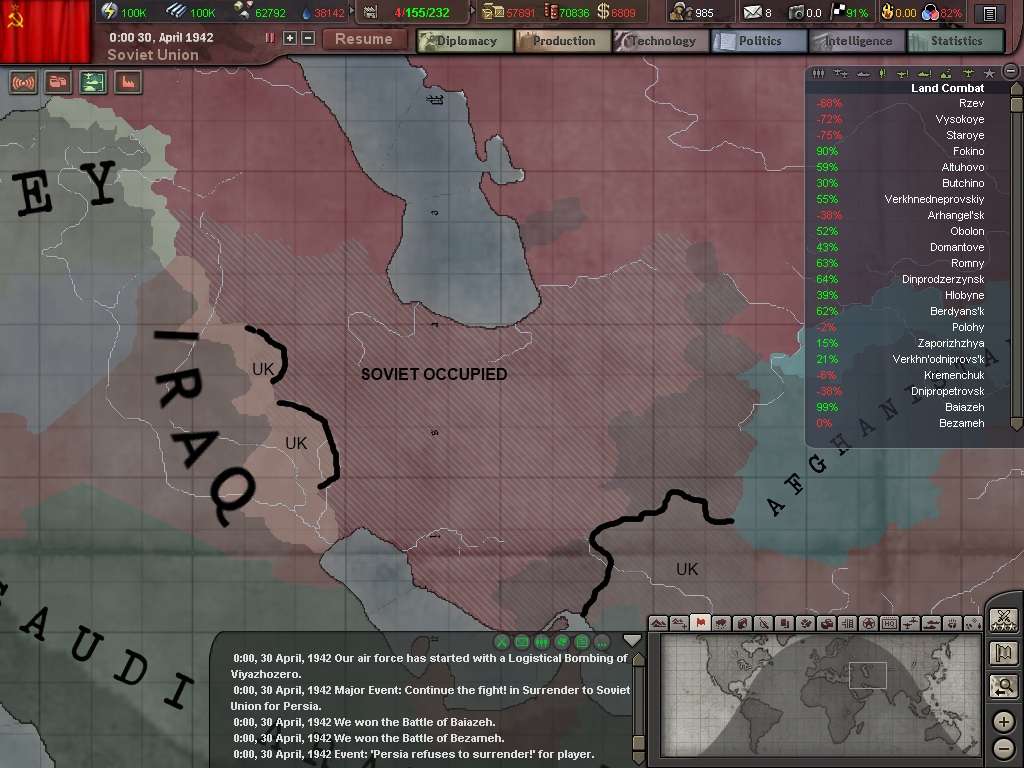The Great Patriotic War
- Thread starter loki100
- Start date
-
We have updated our Community Code of Conduct. Please read through the new rules for the forum that are an integral part of Paradox Interactive’s User Agreement.
You are using an out of date browser. It may not display this or other websites correctly.
You should upgrade or use an alternative browser.
You should upgrade or use an alternative browser.
Don't worry people! No one's better in prolonged campaigns of attrition than the Red Army!
PS. If, and when you push the enemy back. Please have mercy on the Finns. They didn't mean to join Hitler. It sorta just... happened.
PS. If, and when you push the enemy back. Please have mercy on the Finns. They didn't mean to join Hitler. It sorta just... happened.
I wanna knwo how many brigades you got and how many the germans got and how much manpower you got and how much manpower germany have....could you post the strength of your forces and germanys forces and manpower? (forces=arcraft,ships,army)?
please
please
There are some bona fide successes there, but... It's March. How long is the winter still going to last and how much can the Germans recover when the weather lightens up? I'm looking forward to see if your next round of offensives can sustain the momentum, or if the Germans break your streak of success. 
General Winter should call it quits on April 1st, IIRC, so then the RKKA won't be as effective in defensive battles.
More importantly, are the secondary theaters diverting too many units from the front line. If I remember Loki's earlier discussions, the Persians should be ready to declare war.
More importantly, are the secondary theaters diverting too many units from the front line. If I remember Loki's earlier discussions, the Persians should be ready to declare war.
In Soviet Russia, infrastructure prevents counterattacks.
In this case, what it does do is to stop me recovering org after I take a province, that is going to be a problem for the next year as I fight over provinces either repeatedly or where I trashed the German supply lines
In soviet russia, you dont shoot bullets, bullets shoot YOU!
Answering this could lead me to channelling Arthur Packer, this is obviously why the Soviets imposed reparations on the axis countries post-war, to make them repay the cost of all the bullets they stole?
Don't worry people! No one's better in prolonged campaigns of attrition than the Red Army!
PS. If, and when you push the enemy back. Please have mercy on the Finns. They didn't mean to join Hitler. It sorta just... happened.
At this stage I had the manpower to play the attrition game (& in any case had very little choice but to attack in this style), its later in 42 when manpower gets very tight I have to be much more creative, but fortunately the Germans are in the same mess.
Finland is finally resolved in a mutually acceptable manner, but it remains a potential threat for an age yet. I don't know why they didn't just accept the german call to arms (checking the saves the Germans asked them quite often) when people like Brazil and Peru were more than happy to do so.
There are some bona fide successes there, but... It's March. How long is the winter still going to last and how much can the Germans recover when the weather lightens up? I'm looking forward to see if your next round of offensives can sustain the momentum, or if the Germans break your streak of success.
In the north, end March is end of the winter, one problem with the HOI3 weather system is you get too little post winter mud, so it leaps from very constrained due to bad weather to perfectly clear much too fast.
Although I'm getting less than I wanted, I'm reasonably pleased with how this is now going, the Germans are getting chewed up, their allies in particular are suffering badly, the problem is I need to nip off the tail to their troops up around Archangelsk before the winter supply transport malus is lifted - so I've got a max of 5 weeks to do this!
General Winter should call it quits on April 1st, IIRC, so then the RKKA won't be as effective in defensive battles.
More importantly, are the secondary theaters diverting too many units from the front line. If I remember Loki's earlier discussions, the Persians should be ready to declare war.
The actual game event for some reason runs to 1 June - its a nice boost to org and morale, so it allows me to sustain operations slightly more than otherwise.
I had to divert just enough reinforcements to Central Asia for it to hurt me badly in the Arctic - on a low density front 5-6 divisions would have made a huge difference to what I could achieve.
I wanna knwo how many brigades you got and how many the germans got and how much manpower you got and how much manpower germany have....could you post the strength of your forces and germanys forces and manpower? (forces=arcraft,ships,army)?
Will do, but in about 4 posts from now when I wrap up the winter events and set the scene for a pretty dramatic spring-summer 42. In essence, esp with their allies, the Germans either outnumber or match my strength, so my challenge all the time is to look for small advantages and lever as much gain as I can out of those - hence my interest in using the VVS to hammer their supply networks etc.
I've been thinking about how best to chop up the remaining material for the winter campaigns and finally worked out how I'll do it, so:
a) Persia;
b) Kalinin sector in March-early April;
c) Rest of arctic jan-early April (the fighting to the east of the Rybinsk and around Archangelsk);
d) the Ukraine (Jan was very quiet, Feb somewhat explosive) - depending this'll be either one or two posts, need to look at it a bit more carefully;
e) Naval war - enough odd bits here and there to be worth some scrutiny
f) a sort of 'state of the nation' report and Soviet planning for 1942
then its back and forth across the USSR with massive pockets on both sides, to start the winter 42-43 battles pretty much where this lot end.
As a longer term plot teaser, I've just played the first hours of Jan 1944 & the Germans are on the offensive in one sector and still hanging onto Soviet territory in the Baltic regions. Elsewhere the RKKA is grinding its way into the Carpathian region and snagged up on the Vistula, by this stage Soviet war dead are well over 2.7m and the Axis have lost 3.5m (incl for both units destroyed in pockets).
Thanks for all the comments and to all readers ... there maybe another post today (depends a bit on other things), if not then best wishes to you all.
Roger
This AAR keeps delivering. I think I honestly have to say it's my favorite at the moment.
Can't wait for the next update, so if you find the time to post it today that would be great!
Can't wait for the next update, so if you find the time to post it today that would be great!
Loki, can you tell me where you have been finding all these great pictures?
From a variety of sources - on the German side the WikiCommons site is good:
http://commons.wikimedia.org/wiki/Category:Battles_of_the_Eastern_Front_(World_War_II)
it has a load of WW2 era photographs from the Wehrmacht.
For the Soviet side this resource is excellent:
http://www.battlefield.ru/ru.html
If you switch over to English the navigation is pretty easy, helps if you can transliterate from Cyrillic script but no more than that
This has served me well too: http://www.ww2incolor.com/soviet-union/?g2_page=7
and then I've found a load by just running searches - the wonderful one with a T-34 towing ski troops came off a search for "T-34, winter, images"
This AAR keeps delivering. I think I honestly have to say it's my favorite at the moment.
Can't wait for the next update, so if you find the time to post it today that would be great!
as an early pressie ... here you go
"So clear of Victory" – Persia, February – April 1942.
The formations in the Caucasus were seen by STAVKA as a strategic reserve. If the Germans did manage to break through at Stalino and Kharkov, those forces could be shifted to the line of the Don to protect the vital oil fields at Gorki and Baku. Equally if the Italians over-ran the British in Egypt (and in early Spring 1942 this seemed quite possible) then those forces could protect Baku.
Notionally the Caucasus Theatre was also meant to guard against a possible Turkish invasion. Reports from TKP (Turkish Communist Party) cadres and the NKVD confirmed that the Germans were putting pressure on Turkey to join the axis. Equally it was no surprise that the Turks had dreams of recovering the Levant and Iraq that they lost in 1918, nor that they dreamt of a pan-turkic patchwork of states stretching across the Caucasus and into Central Asia. What was very clear was that Turkey would take no aggressive actions unless both the USSR and the UK were on the verge of defeat.
However, the Germans were also seeking to draw Persia into the Axis, and here they found a more ready audience.

(Reza Shah, leader of Persia in early 1942, later lived in exile in Brazil)
They did not have Turkey's bitter memories of defeat and were lured by promises of reincorporating the Iranian speaking areas of the Soviet Union (Southern Uzbekistan and Tajikistan) as well as the Shia dominated regions of Eastern Iraq. They were perhaps too ready to believe German stories of how the Soviets were committing their very last reserves in an attempt to hold Moscow (which was bound to fall in the Spring) and how the Italians were on the verge of crossing the Suez Canal. Thus Persia joined the axis in early February

and then hesitated on the verge of war. That hesitation, combined with a fatal under-estimation of the Soviet strength in the Caucasus was to set the scene for the subsequent campaign. STAVKA ordered almost all the formations in region to deploy to the Persian border (leaving a garisson at Batum in case of an ampibious invasion across the Black Sea from Rumania).
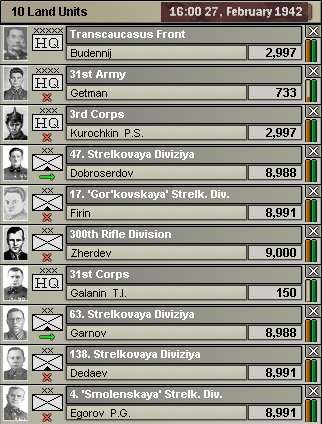
These troops were still in transit when Persia finally declared war on 24 February.
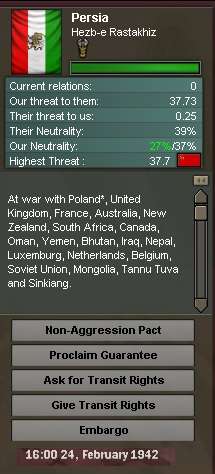
Here they made their second miscalculation. The great bulk of their army struck into the Turkmenistan Republic along the east of the Caspian leaving only reserve formations to screen the Caucasus and to guard Tehran. STAVKA had stripped the Central Asian theatre to cope with the Japanese incursion and had only left a DNO formation at Ashqabat and a single rifle division (78) near Tashkent.
A third advantage the Soviets held was the degree of resistance to the war in Persia and the existence of a strong local Communist Party (the Tudeh).

(Tudeh irregular formations supporting the Soviet attack at Tehran)
STAVKA quickly gathered intelligence about the disposition and plans of the Persian army. From the Caucasus front, 3rd Corps was ordered to take Tehran and 31st to drive south to the Persian Gulf.
In effect, the campaign would be waged by forces already in reserve and offered the strategic prize of ports on the Indian Ocean (with the capacity to interdict any sea borne trade in that region). The British too, belated, realised this, so in many places the war was a race for the oilfields at Ahvaz and the port at Bandar-e-Abbas.
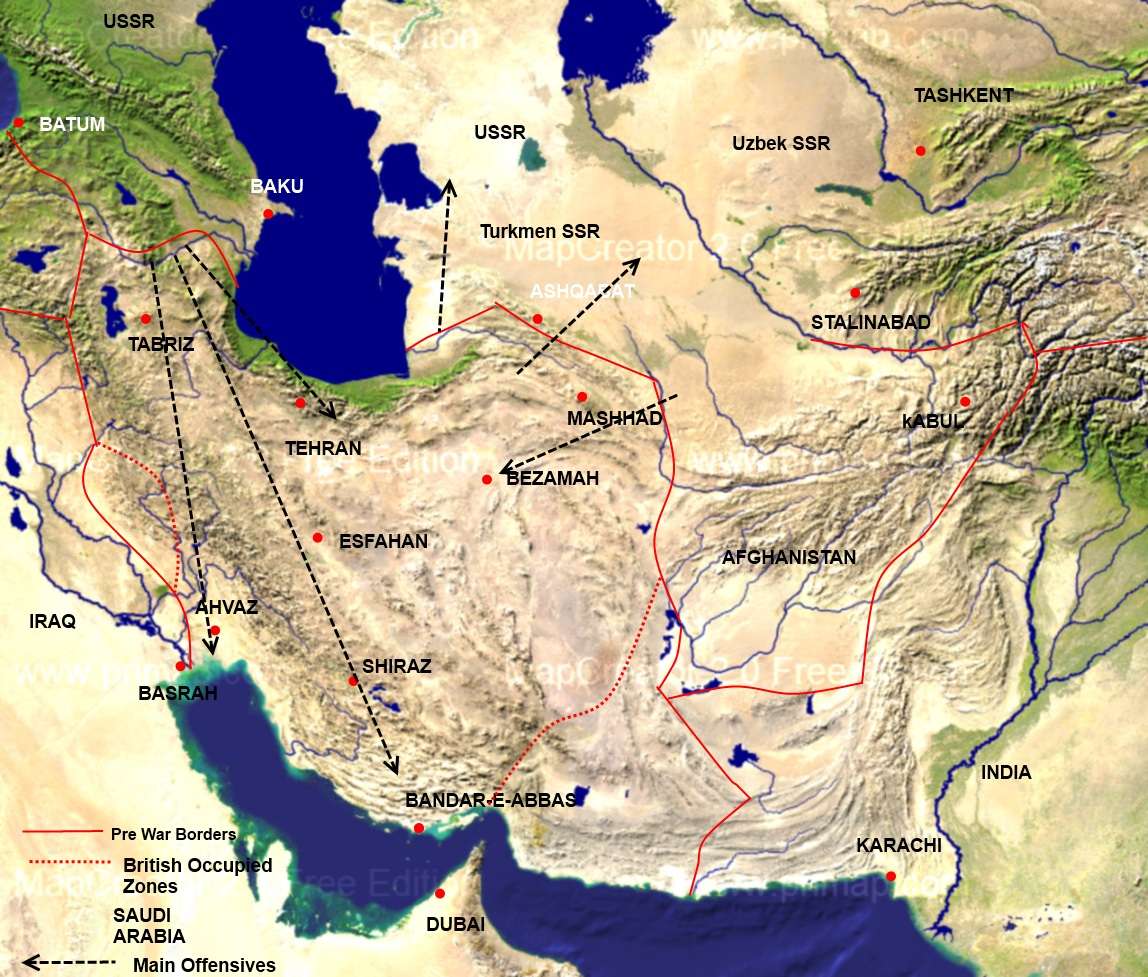
For the most part it was a campaign of manouvre, Tehran fell on 24 March
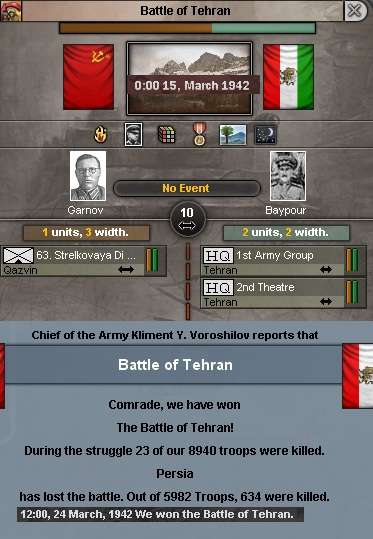
, and Soviet forces won the race for Bandar-e-Abbas.
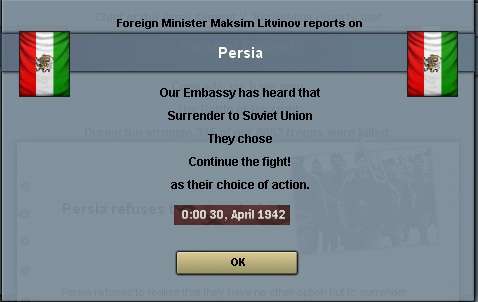
The only battle with significant Soviet losses was at Bezameh in the east where 78 Rifle had been surrounded when trying to cut the supply lines to the Persian forces occupying Turkmenistan. The formation was probably saved from destruction by the surrender of Persian forces on the 30 April.
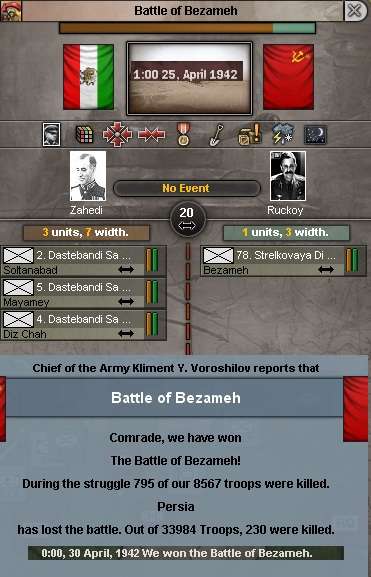
The British insisted on retaining their small gains along the Euphrates in the West and in Baluchistan in the east.
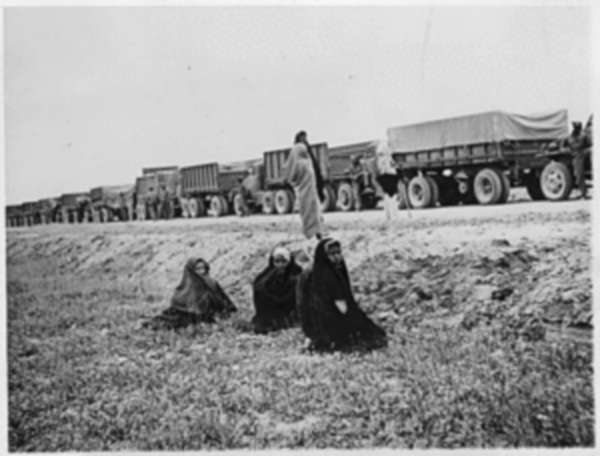
(British Imperialist forces occupying SE Iran)
Given the strength of the Tudeh, the Soviets were content to hand as much of the practical administration to local control.
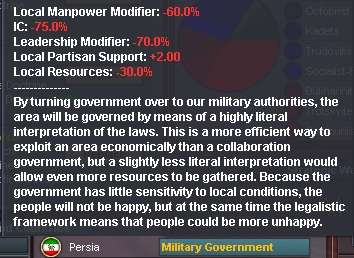
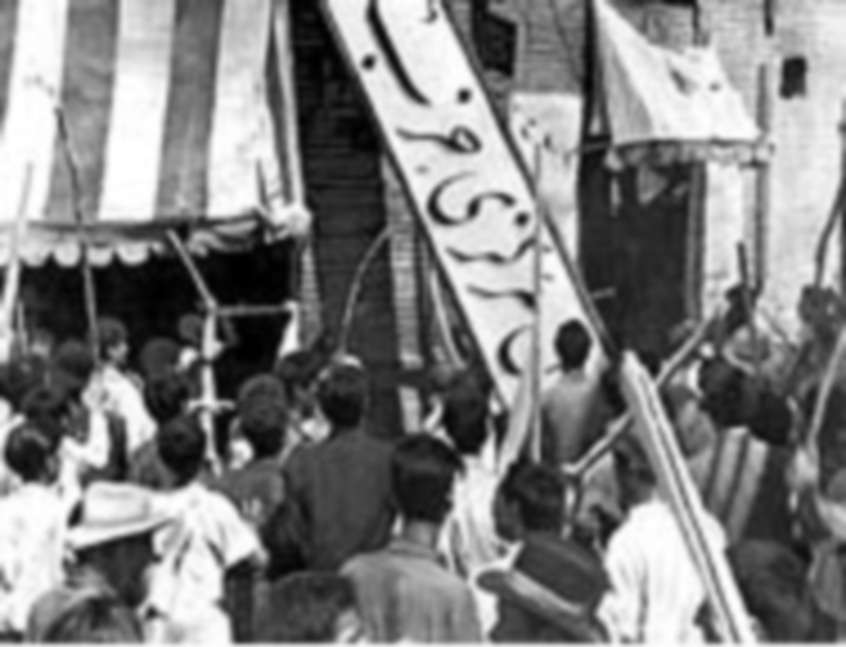
(Tudeh HQ in Tehran)
Additional garrison troops were deployed to the major cities, a small offensive force left at Bandar-e-Abbas and Ahvaz. 4 divisions, including a freshly raised cavalry formation that had taken part in the later stages of the campaign were re-allocated to Central Asia and the balance redeployed to the Turkish border. Somewhat unwillingly, the Soviets allowed the British to send forces from India to the Middle East. In the short term, stopping the Italians before they could occupy Iraq was in the USSR's own interests.
For the loss of 1400 Soviet lives (800 at Bezamah alone) and 3000 Persian troops, the first member of the axis had been forced out of the war. Even better, the USSR now had a potentially powerful position in the Middle East and on the western flank of British occupied India.
Bandar-e-Abbas was steadily built up as a naval and signals base and heavily fortified. Given the fast developing Soviet appreciation of submarine warfare, it had the potential to bring UK communications to and from India to a halt in the event of conflict.
The formations in the Caucasus were seen by STAVKA as a strategic reserve. If the Germans did manage to break through at Stalino and Kharkov, those forces could be shifted to the line of the Don to protect the vital oil fields at Gorki and Baku. Equally if the Italians over-ran the British in Egypt (and in early Spring 1942 this seemed quite possible) then those forces could protect Baku.
Notionally the Caucasus Theatre was also meant to guard against a possible Turkish invasion. Reports from TKP (Turkish Communist Party) cadres and the NKVD confirmed that the Germans were putting pressure on Turkey to join the axis. Equally it was no surprise that the Turks had dreams of recovering the Levant and Iraq that they lost in 1918, nor that they dreamt of a pan-turkic patchwork of states stretching across the Caucasus and into Central Asia. What was very clear was that Turkey would take no aggressive actions unless both the USSR and the UK were on the verge of defeat.
However, the Germans were also seeking to draw Persia into the Axis, and here they found a more ready audience.

(Reza Shah, leader of Persia in early 1942, later lived in exile in Brazil)
They did not have Turkey's bitter memories of defeat and were lured by promises of reincorporating the Iranian speaking areas of the Soviet Union (Southern Uzbekistan and Tajikistan) as well as the Shia dominated regions of Eastern Iraq. They were perhaps too ready to believe German stories of how the Soviets were committing their very last reserves in an attempt to hold Moscow (which was bound to fall in the Spring) and how the Italians were on the verge of crossing the Suez Canal. Thus Persia joined the axis in early February

and then hesitated on the verge of war. That hesitation, combined with a fatal under-estimation of the Soviet strength in the Caucasus was to set the scene for the subsequent campaign. STAVKA ordered almost all the formations in region to deploy to the Persian border (leaving a garisson at Batum in case of an ampibious invasion across the Black Sea from Rumania).

These troops were still in transit when Persia finally declared war on 24 February.

Here they made their second miscalculation. The great bulk of their army struck into the Turkmenistan Republic along the east of the Caspian leaving only reserve formations to screen the Caucasus and to guard Tehran. STAVKA had stripped the Central Asian theatre to cope with the Japanese incursion and had only left a DNO formation at Ashqabat and a single rifle division (78) near Tashkent.
A third advantage the Soviets held was the degree of resistance to the war in Persia and the existence of a strong local Communist Party (the Tudeh).

(Tudeh irregular formations supporting the Soviet attack at Tehran)
STAVKA quickly gathered intelligence about the disposition and plans of the Persian army. From the Caucasus front, 3rd Corps was ordered to take Tehran and 31st to drive south to the Persian Gulf.
In effect, the campaign would be waged by forces already in reserve and offered the strategic prize of ports on the Indian Ocean (with the capacity to interdict any sea borne trade in that region). The British too, belated, realised this, so in many places the war was a race for the oilfields at Ahvaz and the port at Bandar-e-Abbas.

For the most part it was a campaign of manouvre, Tehran fell on 24 March

, and Soviet forces won the race for Bandar-e-Abbas.

The only battle with significant Soviet losses was at Bezameh in the east where 78 Rifle had been surrounded when trying to cut the supply lines to the Persian forces occupying Turkmenistan. The formation was probably saved from destruction by the surrender of Persian forces on the 30 April.

The British insisted on retaining their small gains along the Euphrates in the West and in Baluchistan in the east.

(British Imperialist forces occupying SE Iran)
Given the strength of the Tudeh, the Soviets were content to hand as much of the practical administration to local control.


(Tudeh HQ in Tehran)
Additional garrison troops were deployed to the major cities, a small offensive force left at Bandar-e-Abbas and Ahvaz. 4 divisions, including a freshly raised cavalry formation that had taken part in the later stages of the campaign were re-allocated to Central Asia and the balance redeployed to the Turkish border. Somewhat unwillingly, the Soviets allowed the British to send forces from India to the Middle East. In the short term, stopping the Italians before they could occupy Iraq was in the USSR's own interests.
For the loss of 1400 Soviet lives (800 at Bezamah alone) and 3000 Persian troops, the first member of the axis had been forced out of the war. Even better, the USSR now had a potentially powerful position in the Middle East and on the western flank of British occupied India.
Bandar-e-Abbas was steadily built up as a naval and signals base and heavily fortified. Given the fast developing Soviet appreciation of submarine warfare, it had the potential to bring UK communications to and from India to a halt in the event of conflict.
Last edited:
Do you know your units fight better with higher National unity?
And losing Archangelsk!
And losing Archangelsk!
you lost archangielsk but now you have land connection to allies and a seaport to indian ocean 
and now islamist fundamentalism might never be born...
and now islamist fundamentalism might never be born...
...and now islamist fundamentalism might never be born...
Or we'll see it spring to prominence some 40 years early. Depends on how persuasive the Tudeh can be, I guess.
Well, that was a nice bright spot for the Soviets. The clearest (and cheapest) victory yet. What a lovely way to start 1942.
Some additional IC is always nice. I know the Middle Eastern countries have essentially none, but I think Persia may be the exception.
Good stuff, although that was certainly a rather foolish choice from Persia. Still she has supplied you with strategically important lands, and I like the reference to these new lands proving useful for a future possible conflict with Britain. Such a war would prove very intriguing.
Do you know your units fight better with higher National unity?
And losing Archangelsk!
you lost archangielsk but now you have land connection to allies and a seaport to indian ocean
and now islamist fundamentalism might never be born...
Or we'll see it spring to prominence some 40 years early. Depends on how persuasive the Tudeh can be, I guess.
Well, that was a nice bright spot for the Soviets. The clearest (and cheapest) victory yet. What a lovely way to start 1942.
Some additional IC is always nice. I know the Middle Eastern countries have essentially none, but I think Persia may be the exception.
Happy Holidays to you as well loki - that went better than I expected!
Good stuff, although that was certainly a rather foolish choice from Persia. Still she has supplied you with strategically important lands, and I like the reference to these new lands proving useful for a future possible conflict with Britain. Such a war would prove very intriguing.
It was a lot easier than I feared when they joined the axis. I had about 8 divisions in the Caucasus and my expectation was they'd face the bulk of the Persian army, so if the Brits moved themselves then my expectation was for a long slow struggle to Tehran whilst the UK cleaned up in the south. Their decision to occupy the deserts of Turkemenistan reduced it to little but a race for the VPs.
A bit later I reset the occupation policy to the most benign. While I do need the IC, I was finding leadership/manpower a much more immediate constraint, so was content to forego the IC and never actually needed the resources.
Well if the British Imperialists chose to dispute the Red Army's victory (late Jan 44 & its not in sight yet!), then yep Bander-e-Abbas, well protected with long range subs (& I've put a lot of research into my subs) means they have no way to ship supplies in/out of India. I've come to really like subs, they may not win a war for you but all those convoy sunk pop-ups have cheered me up at various bleak moments.
It depends on when/how the war with Germany ends, I then want to deal with Japan and then we'll see what the fall out is with the UK (or US if it ever wakes up - to be fair they end up somehow in a limited war with Japan later in 1942).
Re: NU I agree but my domestic spies are very busy keeping the Germans out (or at least under control) so that just has to slip over time. An officer ratio bumping around 89-91% is also a major problem that I had to shift a lot of leadership to improve on throughout 1942.


